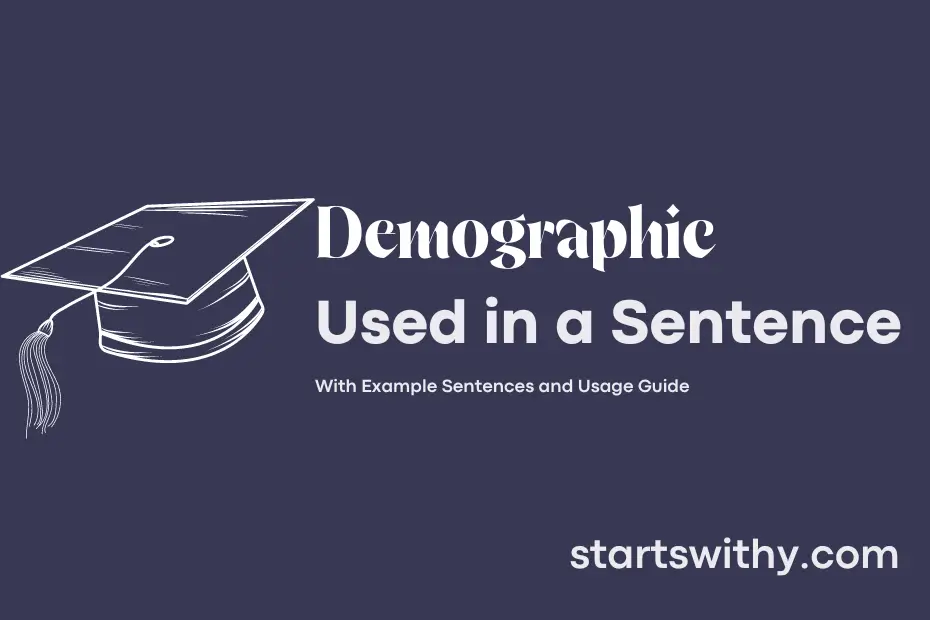Do you ever wonder who makes up a particular group of people? If so, you are pondering about demographics. Demographics refer to the characteristics or attributes of a specific population, such as age, gender, income level, education, and more.
Understanding demographics is crucial for businesses, governments, marketers, and researchers to tailor their products, services, and initiatives to meet the needs of their target audience effectively. By analyzing demographic data, organizations can gain valuable insights into consumer behavior, preferences, and trends, enabling them to make informed decisions and strategies.
7 Examples Of Demographic Used In a Sentence For Kids
- India has a diverse demographic with people from different regions.
- The demographic of our class includes children of various ages.
- We can learn about each other’s cultures based on our demographic differences.
- The demographic of a town can change over time as more people move in.
- It is important to respect everyone in our demographic and treat them kindly.
- Our demographic includes families from different economic backgrounds.
- Understanding the demographic of a place helps us learn more about its people.
14 Sentences with Demographic Examples
- Demographic data indicates that the majority of college students in India are between the ages of 18 to 24.
- Understanding the demographic makeup of your classmates can help improve group projects and collaboration.
- It is important to study the changing demographics of the Indian workforce for future career planning.
- The university administration closely monitors the demographic shifts in student enrollment each year.
- The marketing department conducts research on the demographic profile of potential students to tailor their campaigns effectively.
- College clubs often organize events based on the interests of the student demographic they cater to.
- The government uses demographic data to allocate resources for educational institutions in different regions of India.
- Various academic studies focus on analyzing the demographic trends among college graduates in the country.
- Social media platforms target the college student demographic with relevant advertisements and content.
- It is interesting to observe the demographic diversity among international students studying in Indian universities.
- Career counselors take into account the demographic backgrounds of students when offering guidance on job opportunities.
- The university cafeteria offers a diverse menu to cater to the varied demographic preferences of students.
- Student clubs often conduct surveys on the demographic distribution of their members to plan inclusive activities.
- Understanding the demographics of the local community can help college students engage in meaningful social service projects.
How To Use Demographic in Sentences?
Demographic refers to a specific segment of the population that shares common characteristics such as age, gender, income level, and interests. When using demographic in a sentence, make sure to identify the target group you are referring to.
For example: “The marketing campaign was tailored to a younger demographic aged between 18-24.” In this sentence, the word demographic is used to specify the age group that the marketing campaign is focusing on.
Another example could be: “The new product is designed to appeal to a diverse demographic including both men and women.” Here, the term demographic is used to describe the different groups within the population that the product is targeting.
When using demographic in a sentence, try to provide specific details about the characteristics of the group you are referring to. This will help convey a clearer message and ensure that the intended audience is understood.
In summary, demographic is a term used to describe a particular group within the population, and it is important to provide context and details when using it in a sentence.
Conclusion
In conclusion, the examples of sentences with the keyword “demographic” highlight the significance of understanding specific group characteristics for tailored marketing strategies and services. By analyzing demographic data, businesses can effectively target their desired audience and enhance their reach. Identifying key demographic factors such as age, gender, income, and location allows for personalized communication and product offerings that meet the diverse needs of different consumer segments.
Overall, recognizing the importance of demographic segmentation in decision-making processes is crucial for organizations seeking to achieve success in a competitive market. By utilizing demographic insights to inform business strategies, companies can position themselves more effectively, increase customer satisfaction, and drive growth. Embracing demographic analysis ensures that businesses remain relevant and responsive to the evolving preferences and behaviors of their target demographic groups.



